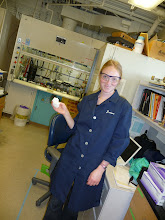Ultraviolet (UV) radiation has wavelengths in the range of 200 nm to 300 nm. If you recall the relationship between energy and frequency, E=hv, where v=c/wavelength and c=the speed of light, then we can see that the energy of UV light can range from about 95 kcal/mol to 143 kcal/mol.
Energies in this range are sufficient to induce electronic absorption in molecules. Common organic molecules contain bonds that can be broken with the amount of energy contained in UV light.
One reaction in particular that is driven by UV light is the [2+2] cycloaddition of two thymine molecules in DNA. As you may already know, DNA is composed of two strands of connected nucleotides. Each nucleotide is made up of a nitrogen-containing heterocycle (cytosine, guanine, thymine or adenine), a sugar, and a phosphate group, which links each nucleotide to the next one in a long chain of nucleotides.
 Since thymine has a double bond, it can undergo a reaction known as "cycloaddition," in which two double bonds connect with each other to form a four-membered ring (cyclobutane). As you can see below, this is a significant change! Anything that significantly alters the structure of your DNA can have drastic consequences on a number of different processes in your body.
Since thymine has a double bond, it can undergo a reaction known as "cycloaddition," in which two double bonds connect with each other to form a four-membered ring (cyclobutane). As you can see below, this is a significant change! Anything that significantly alters the structure of your DNA can have drastic consequences on a number of different processes in your body. The [2+2] cycloaddition of thymine is only one of many reactions that can occur in the presence of high energy UV radiation. So wear your sunscreen!
The [2+2] cycloaddition of thymine is only one of many reactions that can occur in the presence of high energy UV radiation. So wear your sunscreen!




No comments:
Post a Comment